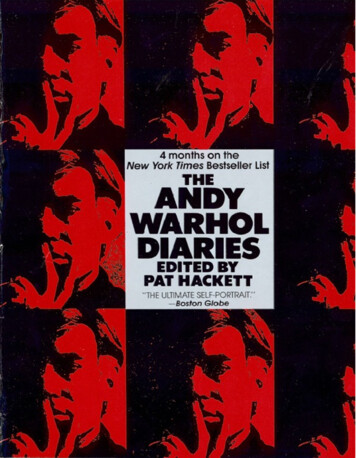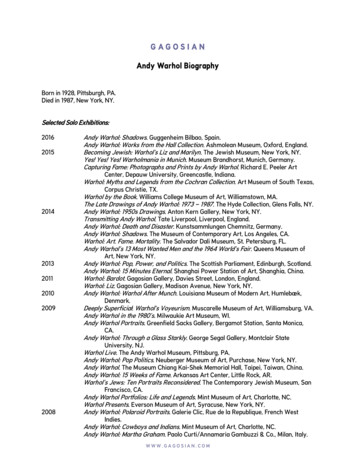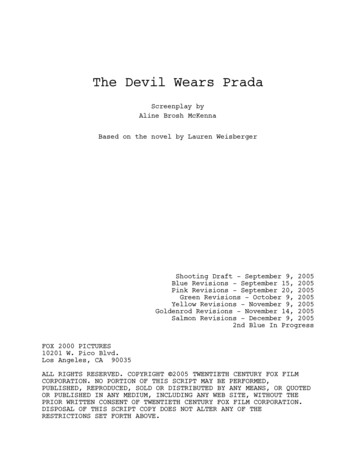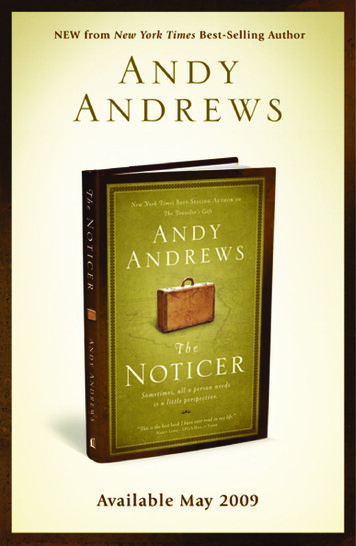
Transcription
;::,-: 5Andy.J35 1942 1949 1956 1963 1970 S77 1111
Artists in TheirTimeAndyWarholLinda BoltonFranklin WattsANew YorkDivision of Sclnolastic Inc.TorontoIVIexico CityLondonNewDeliniAucl lanclSydneyHong KongDonbury, Connecticut
Firstpublished in 2002 byFranklin Watts96 Leonard StreetLondon EC2A 4XDFirstAmerican edition publishedin2002 by Franklin WattsADivision of Scholastic Inc.90 Sherman TurnpikeDanbury.CT 06816Series Editor:Adrian ColeSeries Designer:Mo ChoyArt Director: Jonathan HairPicture Researcher: JulieAisCIPMcMahoncatalog record for thistitleavailable from the Library of Congress.ISBN 0-531-12225-5(Lib. Bdg.)ISBN0-531-16618-X(Pbk.)Printed inHong Kong, China Franklin Watts2002Acknowledgements The Andy Warhol Foundation for the Visual Arts, Inc./ARS, NY and DAGS, London 2002 & The Andy Warhol Foundation for the Visual Arts, Inc./ARS, NY andDACS, London 2002; 29 The Andy Warhol Foundation for the Visual Arts, Inc./ARS, NY and DAGS, London2002; 42. Archives of The Andy Warhol Museum, Pittsburgh: 6; 7t; 9t; 22b; 32, 39 The Andy Warhol Foundationfor the Visual Arts, Inc./ARS, NY and DAGS, London 2002; 4Ib Paul Rocheleau. Artothek: 14 The Estate of RoyLichtenstein/DAGS 2002. BFl GoUections: 35 The Andy Warhol Foundation for the Visual Arts, Inc./ARS, NYAKGLondon: 152002 Ronald Feldman Fine Arts, NY; 19and11DAGS, London2002. Gourtesy of Gollection Stephanie The Andy WarholWarhol FoundationFoundationfor the Visual Arts,for the Visual , LondonThe Brant Foundation, Greenwich, GT:2002; 31 The AndyDAGS, London2002. Bridgeman /Private Gollection 13t Robert Rauschenberg/DAGS, London/VAGA, New York 2002. Bridgeman/Saatchi Gollection, London 17 & covercentre The Andy Warhol Foundation for the Visual Arts, Inc./ARS, NY and DAGS, London 2002. TrademarksLicensed by Gampbell Soup Gompany. All Rights Reserved. Bridgeman/Henry N Abrams Family Gollection 18c The Andy Warhol Foundationfor the Visual Arts,Inc./ARS,NYandDAGS, London2002; Bridgeman/Hungarian The Andy Warhol Foundation for the Visual Arts, Inc./ARS, NY and DAGS,London 2002. Bridgeman/Private Gollection 28c Succession Marcel Duchamp/ADAGP, Paris and DAGS London2002. Garnegie Mellon University Archives: 9b. Ghristie's Images Ltd: 25 The Andy Warhol Foundation for theVisual Arts, Inc./ ARS, NY and DAGS, London 2002; 37 The Andy Warhol Foundation for the Visual Arts,National Gallery, Budapest 21Inc./ARS, NY and DAGS, London 2002. The Goca Gola Gompany: 12b/Advertising Archives. Gonde Nast NY: 10cVogue Gover/Advertising Archives. Gorbis: 16t Bettman; 23 Burstein Gollection The Andy Warhol Foundation forthe Visual Arts, Inc./ARS, NY and DAGS, London 2002; 34c Bettman; 36t Lynn Goldsmith; 40 Liba Taylor. GulverPictures: 8. Edifice: 41 1 Lewis-Darley.General Motors Gorporation 2002: 24b used with permission ofArchives/Advertising Archives. Ronald Grant Archive: 27. Hulton/Archive: Gover bl30b; 33t Santi Visalii Inc; 33b; 34t. Robert&GM MedialOt; 12t; 13b; 22t; 24t; 28b;Hunt Library: 7b. Kobal Gollection: 18t & cover be 20th Gentury Fox;Mark Murphy. Redferns: 20t & b. Rex Features: 36b & cover br.Popperfoto: 30t. Pittsburgh Post-Gazette: 38bStephen Shore: 16b; 26t&b.Whilst every attempt has been made to clear copyrightshould there be any inadvertent omission please applyin the first instance to the publisher regarding rectification.38t.
ContentsWho Was Andy Warhol?6Early Life8TheBig ApplePop ArtCartoon1012Strips14Soup Star16Hollywood Blonde18"The King"20Death and Disaster22American Contrasts24TheFactory26Uncertain Times28A Grieving Widow30Warhol and Film32Productive Years34Back36to the BeginningSelf-Portrait38Warhol's Legacy40Pop Art, Performance Art42Timeline42Glossary44Museums andIndexGalleries4546
"Who Was Andy Warhol?Andy Warhol was one of the most influentialAmericanandartistsof the 20th century. His arthis lifestyle reflected the rapidlychangingculture of his time.Asayoung boy Warhol was obsessed with fameand glamour.HeHollywood film'7myasread fan magazines aboutstars,and collected autographpicturesand newspaper cuttings about them. Hewent tohis localmovie theaterlatest films,which mes, ofmuchculture,a part ofandrocketsmypart ofitastelevision.Andy Warholthehis interest in theo{ the rich and famous.POPART,POP ARTISTAs he grewolder,Warholtransformed this obsession intoHeisfamousshowingHehe madefor the printscelebrities, including thefilm star Marilynrock andart.Monroe andtheroll singer Elvis Presley.also focusedon name brandproducts such as Campbell's soup andBrillo soap pads.These wereallpartof the popular culture of the time,and the subject of what becameknownas the"Pop"was probably the greatestofWarholPop artistartists.them all.The silk-screen technique heused produced very brightly coloredprints. Itwas a commercial processthat allowedhimto print multiplecopies of each artworkonaprinting press.Warholalsomadefilms.were not mainstream filmslike theones at the local movie theater, withAThis hand-colored(asAndy Warhol was knownphotograph shows Andrew Warhola,IITheythen), atagelotso{ characters and a storyline. Hiseight.filmssometimes lastedforhours andmight only feature a single person.
FAMEWarholalso wrotemany booksand produced a magazine calledInterview.thisAsthenamesuggests,magazine published interviewswith celebrities from the world ofrock and pop music, film andandliteratureandart,politics.By the mid- 1960s Warhol wasthe most famous artist in the U.S.Around the world, he was oftenmore famous than the celebritieshe painted.Warholmother(on theJulio, hisleft),with hisaunt Mrs. Preksto,and her stepson George Guke,1937.BACKGROUNDFAMILYWarhol's parents both emigrated to the U.S.from thevillage ofMikova, in whatistodaySlovakia (formerly part of Czechoslovakia).His father, Ondrej Warhola,in 1909, butHea wife.arrivedthen returned to Mikova to findmarried Julia Zavachy and wentback to the U.S.behind to lookstart offirstin 1913. JuliaafterWorld Wardeparture further.her youngerI,Ithadto staysisters.Thein 1914, delayed herwasn' t until 1921, eightyears later, that she was able to join herhusbandin Pittsburgh, Pennsylvania. Inthose days Pittsburgh was an importantcenter for the steel and coal industry. Otherfamilymembersalso lived there, includingone of Ondrej 's brothers, two of Julia'sA A photograph of aMikova, c.1905. At the time,places toemigrate.grow upinsame area assuch villages were harshvillage in theand many people wantedand two of her brothers.Ondrej was a hard-working miner andsisters,toconstruction worker.sons, Paul, John,He and Julia hadthreeand the youngest, Andrew.
"Early LifeAndy Warhol was bornAndrew WarholainForest City, Pennsylvania,on August1928. Later he6,claimed that his birthwas wrong andcertificatethat he was born in 1930, oreven 1931. However, mostpeople think that this wasan attempt to add mysteryandinterest to his earlylife.Warhol's father workedaway from home ahismother caredthree boyslot,andfor theon her ownthrough thedifficult years ofthe Great Depression andWorld WarAII.Thesteeland coalindustriesdominated the landscape of ForestCity.TheIarea was poor and largelymade upof immigrant families from Eastern Europe.Iwhen Warhol was 14, his father died after a longillness. The family was poor but all the boys worked hardand saved what money they could from their part-time andsummer jobs.In 1942,''She'd givemeaHershey Bar everytimeIfinished apageinSTUDENT DAYSmyWarhol had always beencolonng hook.interested inart.In 1945, hegraduated from high school and went to study pictorialdesign at Pittsburgh's famous Carnegie Institute ofAndyWarhul,Technology (knownabout his motherasCIT).Oneof his fellow studentsthere was Philip Pearlstein (b.l924). Pearlstein remembersthatthatWarhol often came over to his house to study, sayingit was too crowded and difficult to study at home.TIMELINEIAugust6,1928Andrew WarholaborninisForest City,Pennsylvania.19421945World WarOndrej Warhola diesaftera three-yearillness.Andy Warhol goes onfinishhigh school.toIIends.1945-49Warholstudies pictorial design at theTechnologystudent.inPittsburgh.MeetsWarhol works duringdepartmentstore,and makesCarnegieInstitute ofPhilip Pearlstein, a fellowthe holidaysfirst visittoinaNewYorkCity.
During the summer, Warhol had to work to earnhis keep.Hewrote,"Ihada jobone summerin adepartment store looking through Vogue and Harper'.sBazaar and European fashion magazines for awonderfullikeman namedMr. Vollmer.50 cents an hour and"ideas."Idon'tmyNewgot somethingjob was to look forremember ever finding oneone. Mr. Vollmer was an idol tofromImeor gettingbecause he cameYork and that seemed so exciting."LEAVING FORNEW YORKWarhol graduated with a degree inHe planned on becoming an art teacher.In June of 1949,Fine Arts.During the summer, however, Pearlstein persuadedhimto go toNewuncertain aboutYork.howThe two menset off,they would manage in thebig city.Philip Pearlstein (on theat Rockefeller Center,NewWarhol sent a postcard home tohis mother everyday and went to church at leasttwice a week. (In 1952, Julia Warhola joined her sonin New York. She remained there until her death 20FromAand Andyleft)Warhol photographed with awomanNew York,friendc.1949.York,to pursue ateaching career but wanted to try and interestmagazines in his artwork instead.adevelopment ofwhat he had been doingeditor for theCITThe work heas a picturestudent magazine,Cano. Over the nextyears later at the age of 80.)Soon Warhol had decided notshowed them wasyears the1 1Warhol produced, with theirsmudged lines, were to become hisprintstrademarkstyle.MCarnegieInstitute ofTechnology campus.Warholfailed perspectivedrawing atCIT,butsummer coursemake the grade. Heattended atograduated on June 16,1949.
TheBig AppleFor Andy Warhol, New York was magical.summerthere, in 1949,heDuring hismagazinetried to interestpublishers in his work. Tina Fredericks, atfirstGlamour magazine,needed drawings of shoes.liked Warhol's drawings but onlyWarhol returned the following day with 50 drawings of shoes.Tina used his drawings to illustrate an article called "Success Isa Job inNew York"Septemberin theissue of theFrom then on Warhol made footwear onehis art. His series"Golden Shoes" paidfavorite stars, featuringthemallVOGUEA The Statue ofNew ' Amagazine Vogue,issue datedway1is950s' designinuses simpleitillustrations ratherthan theglossy color photographsNEW YORKBy1New950,becomeof hiscover for the foshionJune 1958. The covertheYork.manyform of shoes.typical ofa symbol ofLiberty,Aof the subjects o{tribute toin the magazine.weuse today.'o-i Commercial art wasdemandgreatYork hadinthe1in950sand helped launch Warhol'sthe largest city in thecareer.world with a population of over13Wall Street was atmillion.the center of international trade.New. - overlooked bythe Statue of Liberty - suppliedYork's portgoodsallover the world.Newwas also the center ofmagazine and book publishing,Yorktheater (on Broadway),andItWarholdid not take long forcommercialartist.Hetobecomecreated advertisements for magazinessuch as Glamour and Vogue, window displays for departmentstores, illustrations forManhattan, withvarious commercial advertising campaigns. Inexclusiveshops and restaurants, was thebackbonesociety.NewofIt'sAmerican highno wonderthattheforproudYorkers called their city"the Big Apple."Annual ArtI.RCA, and1956, he wonrecord companies such asshowbusiness. The island ofitsa successfulDirectors'Club Awardfor his advertisementMiller Shoes and was invited to exhibit his work.Warhol was very encouraged by this. Toward the end ofthe 1950s he had begun to realize that he wanted to becomea serious artist, not just acommercialartist.TIMELINE1949Warholisemployed as a commercialHarper's Bazaar, producesI.10artist forhis first advertisingVogue andWarholdrawingsHugoforand creates window displays for the departmentBonwit Teller. He shortens his name to Andy Warhol.Millerstore19521954exhibits at theGallery,NewYork. His mothercomestoNewYork.Warhol'sfirstgroupexhibition at the LoftGallery,NewYork.1956Warhol winsAnnual ArtAwardforthe 36thDirectors'anI.ClubMillershoe advertisement.
U Su- }Elvisink,goldPresley (Gold Boot), 1956leaf,collage on paper,20 x 14in(50.8 x 35.6 cm), The Brant Foundation, Greenwich,ConnecticutWarhol depicted variousIn his"Golden Shoes"Otherstars featured in the series includeseries,stars in theform of shoes.Judy Garland, Julie Andrews, and James Dean.11
"Pop ArtknowPop art, emergedin the mid- 1950s. It drew its inspirationfrom the images of popular culture andconsumer society - advertisements,Pc pularart, alsoasmagazines, billboards, cartoonmusic, television, and filmSome Popartistsstrips,popstars.used their art to criticizethe consumer society. Others, like Warhol,neither criticized nor praised, but simplyreflected the thingsaround themat thetime. Warhol, for example, painted everydayproducts - such as Campbell's soup cans,Coca-Colahadthatandbottles,a clearBrilloPad boxes -A An American family shopping,brand design.the start of1what became known as950s, Thethe1950s markedconsumerIMAGES FROM MASS CULTUREThe term "Pop art" was first usedsociety.in 1957, ina meeting about fashion, mass media,science fiction, industrial design, and otherrelated subjects at the Institute ofContemporary Arts (ICA)By the end of the 1950sincludingLondon.ina group of artistsAndy Warhol, RoyLichtenstein(b.l923), Claes Oldenburg (b.l929), andTom Wesselmann(b.l931) were creatingimages based on television commercials,cartoonstrips,produce theirand advertisingart,billboards.they often usedcommercial mass-production techniquessuchas silk-screen printing.''BuyingMidsummer magicismuch moreAmerican than thinking,AA 950s1distinctiveadvertisement for Coca-Colo, then soldshapedadvertisementwere veryisandinVmasAmericanThe brand logo at the top of thebottles.instantly recognizable.attractive to thePopBrands such asthisas they come.artists.Andy Warhol12To
ART FOR EVERYBODYAlthough neverproduceart forPopa formal group,artistswanted toThey used subjects that weresuch as name brand products andeverybody.familiar in everydaylife,newspaper photographs.This idea was immediately successful. Early exhibitions ofPopan enthusiastic response from the public.they were able to understand the art, evenart receivedPeoplefelt likethoughitsmeaning was oftendeliberately unclear.POP ART AND ABSTRACT EXPRESSIONISMInmanyways, Pop art was a reaction to the AbstractExpressionism which had dominated the U.S.during the late 1940s and earlyAbstract Expressionism artist'sartscene'50s.artwhich communicates theemotional state through expressive but abstract marks- was practiced by artists such as Jackson Pollock (1912-56)and Robert Rauschenberg (b.l925). During the '50sRauschenberg changedColaashis ideasbottles, electric fans,and radiosmuchinthe samewayart foreveryone, theyoung Popartistswerereacting to the difficultand often obscure"fast foods"of thefirstwidely available from roadside "fasttextiles,andwas madeusing point,printed matter.showed hotdogs; instead ofstyle offear,they had a shopping basket;instead of passion, forthemthere was popcorn.Leonard Kesseler, one ofWarhol's fellow students atthe Carnegie Institute ofTheyTechnology, remembereddeliberately triedexpress theirwere oneThis pictureAbstract Expressionism.not to use their950s. Hot dogsFeature, Robertdepicting anger andIn their attempt to create1#66 DoubleRauschenberg, 1959.and began painting Coca-the Pop artists were doing.A Eating hot dogs,Aart tohaving the followingconversation with Warhol inownthoughts and feelings, andNewreplaced the serious ideasKesseler:of Abstract Expressionismyou doing?"with images from theWarhol: "I'm starting Popconsumerart."society.York:Kesseler:"Andy! What"Why?"food" stands and eaten on the move.For example, instead ofThey became a symbol of thethinking aboutWarhol: "Becauserepresent theAbstract Expressionism.consumersociety,which did not havetime to wait for a sit-down meal.in paint, thehow tohuman soulPopartistshateareIhateIit!"13
"CartoonInStrips1960-61 Warhol began to make paintings basedon cartoonAmericanHe was unawarestrips.artist,Roy Lichtensteinthat another(b.l923), was alsocreating paintings from blown-up comicillustrations.artistsbookpictures ofSimultaneously but separately, the twoWarholscale.felt frustrated.differentdo!"Hewillhavea lot of impact, that will beIknow what tohim a new idea.don'tpaid Latow 50 to giveOrpaintcan of soup."like aWarholIn 1961 he told his friend,from Lichtenstein.something that everybody sees.the interior designer Muriel Latow, "I've got to dosomething thatmoneyeveryday, that everybody recognizeshad the same idea o{ depicting commercialimages on a very largeShe asked, "What do you likemost in the whole world?" and thentold him, "Money. You should paintinspiration.he sentHe hadsmiled.Thevery next morningmother outhishistobuy one ofthe 32 varieties of Campbell's soup,man-'Top art was justmade.Andy wastherewhenat the right timethey wanted to exposeart aPaul inup cartoonsinfirstbrother(B.I923 exhibited his blown-1962. They were a hugesuccess, proving equally popular with thepublicandthe critics.Although bothartistsused innages frompopular culture, Lichtenstein'sstylewasquite different from Warhol's. Lichtensteinpainted with large dots of bright color toAgive the impression of a solid block ofHopeless, Roy Lichtenstein, 1963. Seen from a distance, the bigdots of color Lichtenstein usedmergeintocolor -one another.inmuchthesame way ascommercial printing does.TIMELINE1957ISeptember 1960Warhol has plasticsurgery fo change theWarhol movesshape ofAvenue.his nose.1342Warhol beginstoLexingtonpictures usingcartoonm&.1419601961to paintblown-upstrips.ttmm itmWarhol creates1962his firstLichtenstein exhibits his cartoonpictures of Campbell'sartwork at Leo Costeiii's gallerysoup cans.NewYork.in
Superman, 1960caseinand wax crayon oncotton,67x52in(170.2 x 132.1 cm), Gunter Sachs CollectionThe cartoon-strip hero Superman was always a popular choice forimagesinto their art.Manyartists trying tointroduceof Warhol's contemporaries also painted their versions ofincluding Philip Pearlstein, Jasper Johns, Robert Rouschenberg,and RoymodernSuperman,Lichtenstein.15
Soup Star Warhol (right) with anumber of friends. Theopening night of aexhibitionSILK-SCREEN PRINTINGchanceof artAround 1962, WarholstartedThisfor printing hisnewnot just ato look at theondisplay.Itworksalsoprovided an opportunity tousing the photographic silk-screenprocesswassocialize.work.was adapted fromtheIntraditional silk-screen technique in1962, at theFerus Gallery inwhich astenciliscut out, placedLos Angeles, Warholagainst a sheet of framed mesh,and then coloredinkisshowed 32 paintingsforcedthrough the mesh onto the paperof Campbell's soupunderneath.cans. Their stylePhotographic silk-screen uses aphotochemical processcameto identify histo transferart.a photographic image onto aThe initial public reaction was disappointing. An art dealermocked Warhol by displaying a stack of real soup cansscreen. During printing, colorscan be changed and manyversions of thesame image cannearby, with a sign reading, "Get the real thing for 29 cents."Thebe made.response to the soup cans was poor in Los Angeles,but sensational inNewYork.They were thestars ofshow, and completely different from what any othertheartistswere creating. Warhol said that the soup cans reminded himof his childhoodwhen heThey remain bold imagesate Campbell'softomato soupAmerican consumerdaily.society.PRINTING THE IMAGESIn the summer of 1962, Warhol began experimenting withcommercial printing technique by using silk-screens (seeleft"The reason I'm painting this way is because I wantto be a machine. I tried doing them by hand, but I find iteasier to use a screen. This way, I don't have to work on myobjects at all. One of my assistants or anyone else, for thatpanel).A Warhol(left)had manyassistantsmatter, can reproduce the design as well asIcould."to help create his prints.TIMELINEISummer 1962Warhol createsfirsthispictures usingsilk-screen printing.16aAugust 1962Warholexhibitssoup cans32pictures of Campbell'sat the Ferus Gallery in LosAngeles Because of lack ofbuys them all himself.interest,October 1962September-October 1962heThe Cubanmissile crisis brings theworld closetonuclearwarafterthe U.S. discovers Russian nuclearmissiles inCuba.Warhol displays his work at thePop Art exhibition "The NewRealists" at theGallery,NewSidney JanisYork.
TomatoSoup Can, 1962casein and pencil on linen, 82/3x62/3 in(22 x 17 cm), Saatchi Collection, London, Englandwell as different types of soup,Although he produced several versions, Warhol's soup cans were never identical. Assometimes the cons ore open and sometimesthe colors of the cans change, there are subtle changes to the lettering,shelf.even have prices on them as if they had just been bought off the supermarketclosed,and some17
Hollywood BlondeAugust of 1962, the film star Marilyn Monroe died of adrug overdose. By the end of that year Warhol had made23 prints of her, all based on a publicity shot for her 1953InWarhol experimented with different colorschemes, painting Monroe against backgrounds of gold,film Niagara.orange, or purple, and giving her blue, green, or purpleeyeshadow. Silk-screen printing madeiteasy forhimto trythese changes.Between August and December of 1962, Warhol producedaround 2,000 pictures, including some of his most famousimages. Over the next ten years he continued to work onthem and reproduced them again andagain.MGreen Coca-ColaBottles,AndyWarhol, 1962.This pictureA Marilyn Monroethe movieino scene fromStable GalleryGentlemen Prefer Blondes.1962.Itimage,nlnllllMarilyn Monroe's realBaker. BorninMiiiiiilLoshow onein thisthe classicColaname wasingraphicallyillustratesA HOLLYWOOD ICONNorma Jeanwasexhibited at thecaseCoca-bottle,can beused to produce avisually excitingAngelesin1926, she spent mostof her childhoodInworkof art.foster care.1946 she became a model,andin1953starred as a"dumb blonde"manytoinfilms,Marry ainthefirstwhich includeMillionaireofHowGentlemen Prefer Blondes.her early deathcameabusetoinInandat the StableAfterWarhol hadGallery in Manhattan,his first solo exhibitionNewYork. Both theAndy Warhol becamefamous overnight.Warhol included his pictures of Coca-Colabottles, Campbell's soup cans, and dollar bills. He alsoincluded his portraits of Marilyn Monroe.In the show,and beauty.Warhol was fascinated by bothdeath and celebrities, so Monroewas aof 1962,public and art critics loved his work.1962, shesymbolize hlollywood'sof youthNovembernatural subject for him.TIMELINEAugust5,1962Autumn 1962INovember 6-24, 1962IMonroe is found deadhome in Hollywood.MarilynheratWarhol beginsin histhefirst"Marilyn" series.printsWarhol hashis first solo exhibition atStable GalleryinNewYork.Eleanor Ward's
[Lavender Marilyn,silk-screen inkandacrylic on linen,196220 x 16in(50.8 x 40.6 cm), Private Collection, Stuttgart,Warhol's portraits of Marilyn Monroe focused particularly on those features that hadlarge red lips, her eyes (especially the color of her eyeshadow), and her thick blondemodeGermanyher beautiful, herhair.19
"The King" Elvis Presley(1935-77) quicklyearned the nicknamebecause ofPelvis"POP MUSIC"Elvis thehip-swinginghisstage performances. Theseperformances excited AmericanIn1950s popular musicthebeganto cater toateenage fans and shockednewElvis alsoconsumer, the "teenager" - awordfirstusedinofKing Creole (1958), and Gl Bluespop music was born.(1960), thatPop music hod mass appealstyles.most famous, rock andmade a numbermovies, including Loving You (1957),- andthe '50sand included manytheirdisapproving parents.TheInwasroll,were huge boxofficesuccesses.the '50sand early '60sElviswas more than a great rock and rollstar. He was also a symbol of thenew postwar America and hero to aa mixture of traditional Americanrhythm and blues, and countrywhole generation whoand western.calledhim"the King."During the '60s, under theinfluence of hippie culture,music changed andpopmany newElvisAfter graduating from high school, where he sang in hisbonds were formed. Warholbecame associatedcalled Velvet1964. Hewith aUndergroundlatersleeve for theirPresley was born in Tupelo, Mississippi, in 1935.he went to workbandchurchinbegan recordingdesigned aalbum Velvetchoir,as a truck driver. In1953 heMemphis, Tennessee. Hewent on to become one of the greatest rock and roll singersof all time and the first teenage idol.forSun RecordsinUnderground and Nico.POP ICONWithhis blue jeans, leather jacket, T-shirt,chewing gum, and slicked-backrepresented aknewthisnew kindand featuredof culture.it.WarholElvis repeatedly, usinghis popularity but at thecontributing tohair, Elvissame timeAs he had donefor his"Marilyn" prints, Warhol experimented withvarious color and image combinations, visuallyachieving very different pictures based on thesamesilk-screen image.Elvis (right)isjustone of many versionsproduced by Warhol. Inthisexample hesprayed the canvas with silver car paint beforeprinting the silk-screen image. Other picturesAndy Warhol designed this coverUnderground and Nico in 967.1for thealbum Velvetshow the image of Elvis reproduced twomore times in one picture.or
Elvis,1963silk-screen inkandsilver paintonlinen,82 x 35in(208.3 x 91 .4 cm),Hungarian National Gallery, Budapest, HungaryThisimage ofElvisemphsizeshis statusas an icon of American youth cultureby almost appearing too large for the page.21
Death and Disasteralso fascinatedfarWarhol wasof American life,contrast to his celebrity pictures,Inby another sidefrom the fame and glamour of showbusiness.Warholwhosaid thatitwas his friend Henry Geldzahlerprovided the inspiration for his "Death and"We were having lunch oneDisaster" series:day insummerand he laid a newspaper out on thetable. The headline was '129 DIE IN JET!' Andthat's what started me on the death series - the Carthe.Crashes, the Disasters, the Electric ChairsA WatchingTV,1960s. Television broughtimages of death and disasterCAPTURING THE DISASTERright intopeople's living rooms.Warhol producedawholeseries of picturespress photographs of real-life disasters,REPEATING IMAGESManywhich had not even been usedinthe "Deathused over and over againin the newspapersWarhol said he didpattern.he believedinscreen printing process, he produced multipleversions of thea gridthischangedtheRepetitionway peopleandmultiplehow heenoughforpeople tomake upreacted toit.have anownminds.secitThe original front coverof the headlinemm ErlE"129 DIEIN JET!" that startedWarhol's interestof deathaTomakepictures,gruesome picture overreallytheir- bombarded by images.over again,were powerfulLri'f images became an''When youexpected otherstimesimportant feature of Warhol's art andreflected a societyorfeltto feel. In his view, the picturesquantity rather than quality,manysame image without making anycomment on how hebecausea phrase he borrowed from industry.Repeating somethingsilk-andsame imageinbased onsome ofbecause they were too gruesome. Using theof the picturesDisaster" series feature theand."andinimagesdestruction.his disasterWarhol generallyused a mixture ofnewspaper photos anddoesn'theadlines which he''projected onto a screen.effect.Andy WarlwlTIMELINEJune 1962IAnarticle ina newspaperWarhol to produce his"Death and Disaster" series.inspiresSeptember 1962Warhol movesto the F irehouseEast 87th Street,NewYork.Autumn 1962onWarhol begins work on1962-63theof his "Disaster" pictures.firstWarhol produceshisthefirst"Car Crash" scenes.of
Green Disaster #2, 1963acrylicandsilk-screen inkon canvas, 30 x 23in(76.2 x 58.6 cm), Burstein CollectionWarhol used powerful, hard-hitting pictures that summed up the way society wasbecoming so used to images of horror that they were no longer shocked by them.23
American ContrastsWarhol acted as a camera or mirror. He reflectedAmericanbrand products,comment.By makingitsThehowMartinL.KingJr. inWashington, D.C.,1nameits- withoutat a sleek,newsthe media themselves treatpages of a glossy magazine orfilledof dreadful events andpage, and acelebrities,political eventsnewspaper are oftenmay lookitsout of a shocking image, heartreminds people ofthese images.-societywith contrasting picturesconsumernewitems.Thecar advertisementreaderon oneand photograph about aarticlegruesome murder on the next.963.In hisart,Warholuses exactly thesame multipleand contradictory imagery produced by the globalmedia - magazines, newspapers, TV, and film.THE FIGHT FOR CIVIL RIGHTSThe Declaration of Independence (adoptedin1776) saidthatallmen are createdequal and have the same rightsandliberty,Howevertolife,the pursuit of happiness.in1960,thisstilldid not applyAmerican population ofto the Africanthe U.S.The1960s'changecivil rightsand Caucasians foughtoftentomettried tov/ithfor justice, theyviolence from thoseopposedchange.Akey leaderwas MartininmovementAs both African Americansthis.inthecivil rightsLuther KingJr.movement(1929-68). BornAtlanta, Georgia, MartinL.King'65 Pontiac Grand Prix.Jr.Nowbecame a powerfulhave a dream," and speaks ofhiswasJr.assassinatedininL.Memphis,A1968.The U.S. experienced both great affluence and violence1963August 19631963IFighting breaks consumer societywere assassinated andTIMELINEcivil rightshas the year's second-best-looking car?"Ithe '60s. While theAprilwhodreamof a racially tolerant America. MartinKingis:public speaker. Hismost famous speech repeats the words,Tennessee,the only questionMartin Luther KingJr.addresses over200,000 peopleWashington D.C.incitiesNovember 1963Gerard MalangaPresidentbecomes Warhol'sisnewDallas, rished, political leadersinraceriots.January 1964Warhol moves1964VelvetUndergroundlarger studio onbeginto231 East 47that the Factory.Street.toarehearse
Birmingham Racescreen-printIn Aprilof1in1964(
Contents WhoWasAndyWarhol? 6 EarlyLife 8 TheBigApple 10 PopArt 12 CartoonStrips 14 SoupStar 16 HollywoodBlonde 18 "TheKing" 20 DeathandDisaster 22 AmericanContrasts 24 TheFactory 26 UncertainTimes 28 AGrievingWidow 30 WarholandFilm 32 ProductiveYears 34 BacktotheBeginning 36 Self-Portrait










